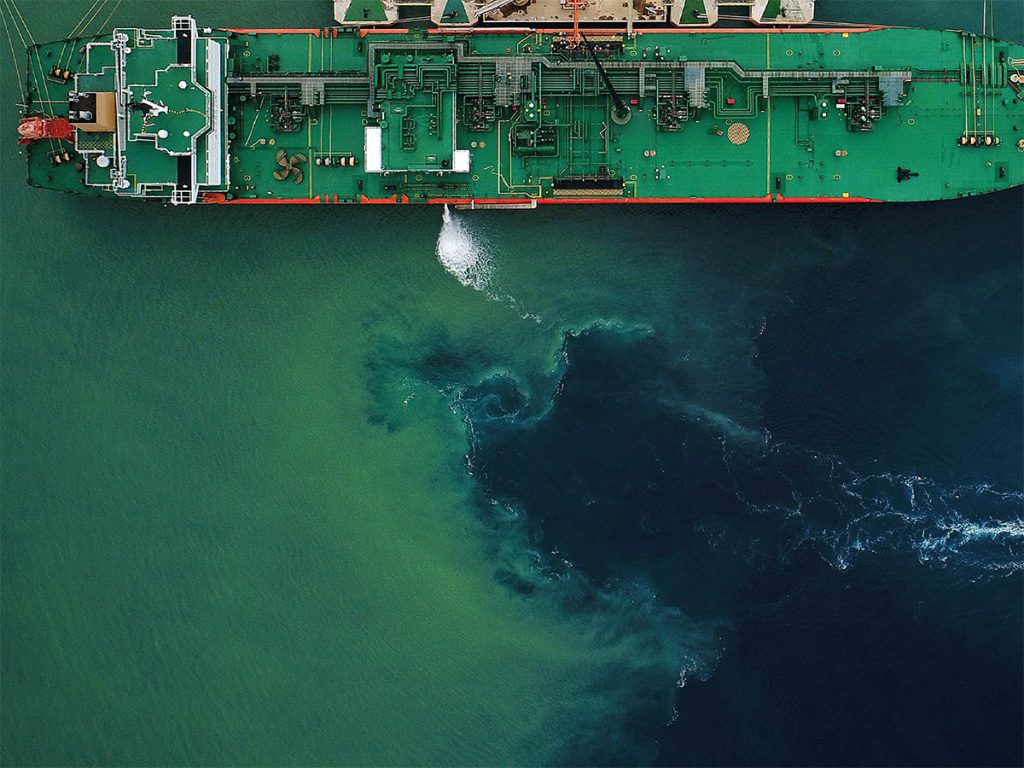As the industry works to curb its environmental impact and reduce emissions, many companies are investing in the use of alternative, ‘green’ fuels. Although boasting green credentials, there are concerns surrounding the use of ammonia as an alternative fuel. Frances Marcellin investigates.
As competition to develop ammonia-ready ships increases in the maritime industry, it is a sign of the times that Japanese shipping company Iino Kaiun has decided to re-enter the ammonia transportation business for the first time since 2017. The company has also agreed a time charter contract for a 23,000m3 ammonia carrier, the first to be designed and built based on the basic certification for ammonia-fuel-ready ships by the American Bureau of Shipping (ABS).
The ship is to be built by Hyundai Mipo Dockyard, for delivery in December 2023. This 160m-long vessel has a beam of 25.5m, a depth of 15.9m, and a draft of 8.1m. It will also transport liquefied petroleum gas (LPG) fuel and can be powered by LPG as well as ammonia fuel.
For years, Iino Kaiun has worked to transport liquefied gases and is aiming to reduce greenhouse gases (GHG) by 40% by 2030. These goals are in line with the IMO’s targets, which aim to reduce GHG emissions from international shipping by at least 50% by 2050.
“The industry is looking at ammonia as one of the pathways towards the decarbonisation goals for beyond 2030,” says Georgios Plevrakis, ABS global sustainability director. “It is a fuel with high potential as a solution for shipping companies looking to decarbonise their operations. It offers shipowners and operators a zero-carbon tank-to-wake emissions footprint, but is not without challenges.”
Ammonia as a fuel
Ammonia is a combination of nitrogen and hydrogen, and thus does not emit any carbon when used to power engines. Today, ammonia production is not carbon free. According to the Royal Society, in its Ammonia policy briefing, around 500 million tonnes of carbon dioxide (1.8% of global carbon dioxide emissions) are currently emitted each year during the process of ammonia production. However, “green ammonia” can be made using sustainable electricity, water and air, making its production entirely carbon free.
“In this process, hydrogen is produced through the electrolysis of water, which is a well-established process,” the Royal Society report states. “Nitrogen is obtained directly from the air using an air separation unit, which accounts for 2-3% of the process energy used. Ammonia is produced using the Haber-Bosch process powered by sustainable electricity.”
Earlier this year A.P. Moller-Maersk launched a feasibility study in ship-to-ship bunkering of green ammonia at the Port of Singapore. “We see green ammonia as an important future fuel for the decarbonisation of our fleet,” Morten Bo Christiansen, VP and head of strategy at A.P. Moller-Maersk said at the time. “A dual fuel Ammonia engine is currently under development.”
One of the great advantages of ammonia as a fuel is the high level of maturity in storage and transport already existing in the world. It is currently traded across 120 ports around the world.
“Ammonia is available to be used as a bunker fuel today – ‘available’ meaning physically present in more than a hundred ports around the world that are equipped to support the 20 million tonnes per year that are traded internationally,” states The Ammonia Report by Carbon Neutral Consulting – a paper written by finance expert and former director of the Clinton Climate Initiative, Milton Bevington; Trevor Brown, executive director of the Ammonia Energy Association; and management consultant Stephen Crolius.
“It helps tremendously both that ammonia is well established as an industrial chemical and as a commodity that the maritime transportation network handles at volume every day.”
Increasing competition
As Japan, China, and Korea hike up their development plans for ammonia-ready vessels, competition is increasing all over the world. At COP26, Australian billionaire Andrew Forrest called for global shipping to aim for a “net-zero 2040 target” and announced plans to launch the world’s first ammonia-powered ship next year by converting a 75m vessel that will run on green ammonia.
“This vessel will show the shipping industry the power of a vessel fuelled by green ammonia in real-world conditions,” he said at the conference. “We are investing heavily in research and development to transform our trains, trucks, and ships with zero pollution fuels as soon as possible. It is a world-leading technology and will assist in providing the shipping industry with the practical know-how to decarbonise completely.”
The first ammonia-fuelled tanker is expected to launch in 2024, the result of a development project between MISC Berhad, Samsung Heavy Industries, Lloyd’s Register, and MAN Energy Solutions.
Using ammonia as a fuel is seen as a key future contributor to shipping’s energy transition.
“Low-speed diesel engines are the most efficient propulsion system for trans-oceanic shipping and already run on a sizable number of emission-friendly fuels,” said Bjarne Foldager Jensen, senior VP and head of two-stroke business at MAN. “We look forward to adding ammonia to the list and welcome the opportunity to work with industry partners in this venture.”
In Europe bold steps are being made. In a world-first move, technology group Wärtsilä and Norwegian ship owner Eidesvik Offshore are converting an offshore supply vessel to operate with an ammonia-fuelled combustion engine by 2023. The ship will be powered by a 70% ammonia blend, but the target is to reach 100% ammonia.
“Using ammonia as a fuel is seen as a key future contributor to shipping’s energy transition, and we’re excited to be the first offshore shipowner taking this step,” said Jan Fredrik Meling, CEO and president of Eidesvik.
Startup Viridis Bulk Carriers is working with cargo owners Elkem, Vestkorn, BioMar, Franzefoss Minerals, and Saltimport to create a zero-emissions network through the development of a fleet of ammonia-powered ships. It envisions deliveries starting in 2024.
Barriers and challenges
Ammonia is a feasible option for the maritime industry because it operates on a global scale. According to The Ammonia Report, the ammonia industry already produces 180 million tonnes of the commodity each year. It states that a 50% share of the maritime industry would require a further 250 million tonnes to be produced. “Increasing production capacity to meet additional demand of this magnitude would require an effort that is significant, but not heroic,” states the report.
The Ammonia Report describes some of the obstacles for ammonia as a shipping fuel, one being that it has a “volumetric energy density that is approximately 30% as great as petroleum fuels”. Having said that, it is higher than liquid hydrogen and less flammable.
Another challenge is that “ammonia is a gas at room temperature and pressure, and can be managed as a liquid only at reduced temperature and/or elevated pressure”. The report states, however, that this hurdle is “not especially daunting” since ammonia’s boiling point of -33° is almost the same as liquefied petroleum gas, which is already used as a marine fuel.
Green ammonia will be more costly to produce in the short term. “The main challenges [of green ammonia] are cost,” states The Royal Society’s report. “About 85% is electricity, which in most parts of the world is still significantly more expensive than natural gas.”
Unlike fossil fuels and even other carbon-free fuels, ammonia is not particularly flammable or explosive.
The Global Maritime Forum reported that a movement to green ammonia would cost more than $1tn investment, however, it is predicted that as demand increases and production rises that costs will reduce – although it is only expected to be cost competitive by 2030.
A further issue with ammonia is its causticity, but Milton Bevington does not see this as an insurmountable problem. “On the subject of safety, ammonia is a widely used industrial chemical whose hazards are well understood; its safe handling and other mitigation practices are governed by regulators,” he explains, adding that while it might be caustic, “unlike fossil fuels and even other carbon-free fuels, ammonia is not particularly flammable or explosive”.
While unfamiliarity of the product to marine bunkering operators is one of the biggest obstacles, Bevington feels that additional training can solve the problem. “Training should not be a challenge, not only because best practices already exist, but also because ammonia is currently handled by ports worldwide. As a result, those already familiar with ammonia handling are close by the bunkering operators who require more training.”
Bevington believes that Ammonia will become “viable as a deep ocean shipping fuel” with the introduction of large ammonia-fuelled power trains in 2024 or 2025, and that ammonia bunkering infrastructure will be built out over the next two decades as demand grows.
“That ought to be a suitable amount of time to create a knowledgeable ammonia bunkering workforce,” he says.
Courtesy: Ship Technology
SLPA Disclaimer: Views are personal do not reflect the opinions and/or views of the publisher























